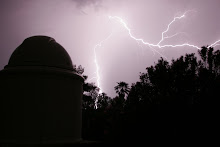Well here we are at the Autumnal Equinox. Each of the two equinoxes marks an exciting change of seasons. The Spring equinox ushers in the long days of summer, with many fond memories of lazy carefree days gone by. The Autumnal equinox announces the coming of long winter nights, the kind where cozy blankets and cups of cocoa bring a peaceful happiness.
But the fall equinox also brings more observing opportunities, especially here in Arizona where the shorter nights of summer are often made useless for astronomy by the monsoon clouds. Quiet, chilly nights at the eyepiece can be some of the most pleasureable (as long as it doesn't get too cold!)
The skies have been clearing up for the past few days. Last night I decided to get started with a photometry program, which is something I've been wanting to do for a long time. So my first foray into this interesting area was to use the ccd to image RX Andromeda, a cataclysmic variable. I used the B, V, and R filters. I'll start off with differential photometry, which basically determines a star's magnitude by comparing the intensity to that of other stars in the field. I've still got some work to do on the data reduction but my first pass at trying to determine a magnitude for RX And resulted in an estimate of 11.355, which is consistent with what other observers have been reporting to the AAVSO (it's currently near its peak). My intention is to monitor this star for at least the next couple of weeks (it seems to have a period of about 2 weeks), and learn enough about how to work on this type of data to submit my observations and magnitude estimates to the AAVSO. I got data both Thursday and Friday nights using the 12", which is currently the scope that is set up in the dome (the 14" is down for maintenance).
Sunday, February 7, 2010
Subscribe to:
Post Comments (Atom)

No comments:
Post a Comment